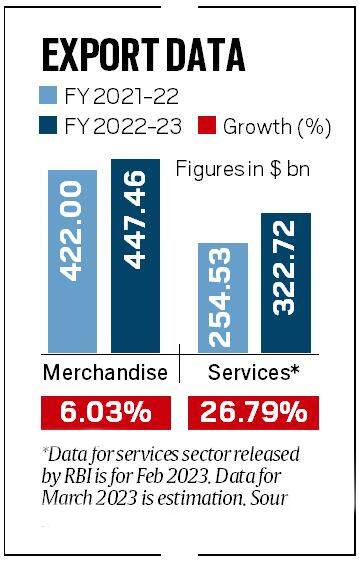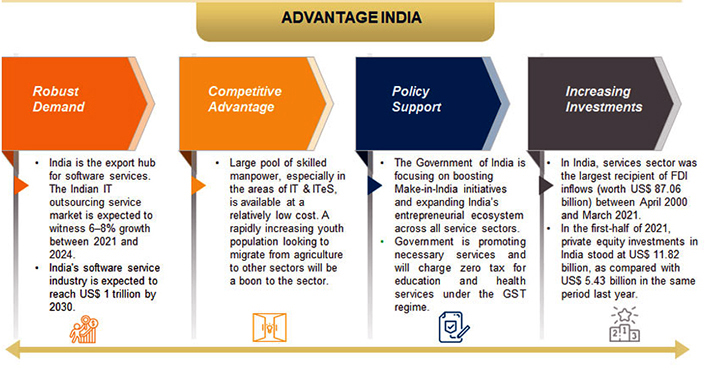Indian Economy
Awaaz Desh Ki: Global Service Export
- 23 May 2024
- 13 min read
For prelims: Gross Value Added, foreign direct investment, World Trade Organisation (WTO), service sector, external sector, current account deficit, Global Capability Centers (GCCs), GIFT City, deficit, merchandise exports, 'knowledge-based economy', GDP, cybersecurity, high-speed internet and digital education, Foreign Tourist Arrivals
For mains: Discuss the Role of India in Global Service Export.
Why in News?
India's service sector continues to notch remarkable achievements, with a recent World Trade Organisation (WTO) report bolstering this narrative by highlighting a doubling of India's share in global service exports with service exports surged by 11.4% in 2023.
What are the Key Highlights?
- Forecasted Growth: Goldman Sachs( a credit rating agency) predicts India's services exports to reach $800 billion by 2030, a substantial increase from $340 billion in the previous year, this growth is expected to bolster the external sector against supply-side shocks and reduce rupee volatility.
- Export Destinations: India exports the most services to North America and Europe, with growing markets in Asia, Africa, and Latin America.
- Current Account Deficit: The current account deficit is estimated to average around 1.1% of GDP from 2024 to 2030, projections for 2024 remain unchanged at 1.3% of GDP, despite potential gains from services exports being offset by geopolitical tensions in West Asia and reduced agricultural exports to Iran.
- Contribution to Global Services Exports: Over the past 18 years, India's contribution to global services exports has more than doubled, India's share in global services exports increased from under 2% in 2005 to 4.6% in 2023, surpassing the growth rate of goods exports, contrasting with China's 10.1% decline in service exports.
- Role of Global Capability Centers (GCCs): The emergence of Global Capability Centers (GCCs) has played a crucial role in India's services export growth.
- These centres have contributed significantly to enhancing India's competitiveness in the global services market.
- Growth Trends in Service Segments:
- Professional Consulting: Professional consulting has emerged as the fastest-growing segment in India's services exports.
- Travel Services: Travel services have shown the slowest growth among service segments.
- Financial Services: Financial services could see significant growth, especially with developments like GIFT City, a financial hub in Gujarat, India.
What is the Service Sector?
- About
- The service sector encompasses industries that provide intangible services rather than tangible goods.
- It includes a diverse range of industries such as finance, banking, insurance, real estate, telecommunications, healthcare, education, tourism, hospitality, information technology (IT), and business process outsourcing (BPO).
- Contribution to GDP and GVA :
- India is the world’s fifth-largest services exporter and the share of the services sector accounted for 54% of the total Gross Value Added (GVA) in FY21.
- The services sector has also been the largest recipient of foreign direct investment, making up 53% of the total inflows between 2000 and 2021.
What is the Significance of the Service Sector for India?
- Balancing Trade Deficit:
- The surplus in services trade has historically mitigated India's significant deficit in merchandise shipments.
- By leveraging this surplus, the country can offset the deficit caused by merchandise exports, fostering greater economic stability.
- Potential for Growth:
- With renewed government focus and strategic interventions, there is immense potential for further growth in services trade surplus.
- This surplus, which stood at around $89 billion in FY21, could expand, signalling a positive trajectory for India's economic performance.
- Transition to Knowledge-Based Economy:
- The service sector plays a pivotal role in India's transition from being primarily an 'assembly economy' to a 'knowledge-based economy'.
- By emphasising services such as IT, finance, and education, India is moving towards an economy driven by innovation, intellectual capital, and high-value services.
- Employment Generation:
- The services sector is a key driver of India’s economic growth, providing employment to nearly 26 million and contributing about 40% to India’s total global exports.
- Global Competitiveness:
- The country's reputation as a service provider of high-quality and cost-effective solutions has attracted businesses from around the world, boosting exports and foreign exchange earnings.
- Diversification of Revenue Streams:
- The service sector provides diversification of revenue streams for the economy, reducing dependency on any single industry or market.
- Enhancing Standard of Living:
- The growth of the service sector contributes to improvements in the standard of living by offering access to essential services such as healthcare, education, and finance.
- It facilitates the development of a robust social infrastructure, leading to a better quality of life for citizens.
What are the Potential Opportunity for India in the Service Sector?
- Tourism Sector:
- The tourism sector serves as a significant driver of economic growth, contributing substantially to GDP, foreign exchange earnings, and employment opportunities.
- In 2017, India's tourism sector performed well, with Foreign Tourist Arrivals (FTAs) growing by 14% to reach 10.04 million and Foreign Exchange Earnings (FEEs) increasing by 19.1% to US$ 27.31 billion.
- Ports, Shipping, and Waterways Services:
- Ports in India handle approximately 90% of export-import cargo by volume and 70% by value, the overall port traffic maintained consistent growth of around 6% between 2015-16 and 2018-19.
- Space:
- India's space programme has experienced significant growth over the past six decades, encompassing various applications such as launch vehicles, satellites for earth observation, telecommunication, navigation, and space science.
- India spent approximately US$ 1.8 billion on space programmes in 2019-20, and in June 2020, the Government of India (GOI) opened up the space sector to enable the participation of the Indian private sector in all space activities.
- Logistics & Transportation:
- India benefits from its natural coastline and extensive river network, providing a competitive advantage in transportation and logistics services both domestically and internationally.
- Information Technology/ Business Process Management (BPM) (IT-BPM/Fintech):
- The Indian IT-BPM industry has been a major contributor to India's exports, witnessing significant growth over the past two decades.
- The sector generated revenues of US$ 190.5 billion in 2019-20, with Software & Engineering Services accounting for a share of 21%, amounting to US$ 40.2 billion in revenue.
What are the Government Initiatives to Promote Service Export?
- Service Exports from India Scheme:
- It was introduced in April 2015 for 5 Years under the Foreign Trade Policy of India 2015-2020.
- Earlier, this Scheme was named the Served from India Scheme (SFIS Scheme) for the Financial Year 2009-2014.
- Under it, incentives are given by the Ministry of Commerce and Industry to Service Exporters based in India to promote the export of services from India.
- Redirecting subsidy resources towards sectors with greater needs can optimise resource allocation and foster inclusive growth.
- Skill India Initiative:
- The Skill India programme aims to provide market-relevant training to over 40 crore youth by 2022.
- Its objective is to equip them with the necessary skills for employment in various sectors, including services.
- Purchasing Managers Index (PMI):
- PMI serves as an indicator of business activity in both the manufacturing and services sectors.
- It provides valuable insights into the health and performance of these sectors, aiding in decision-making and policy formulation.
- Free-Trade Agreements (FTAs):
- The government is actively pursuing FTAs with key economies like the UK, EU, Australia, and the UAE to facilitate market access for Indian service providers.
- These agreements aim to create favourable trade conditions and enhance competitiveness in the global market.
What are the Various Challenges for the Service Sectors in India?
- Global Competition: Intense global competition affects service sectors like IT and BPO. e.g. Indian IT companies face competition from emerging tech hubs like China and Eastern Europe, necessitating continuous innovation and cost-effectiveness to maintain market share.
- Skills Mismatch: Despite initiatives like Skill India, there's a gap between workforce skills and those demanded by the service industry. e.g. in the IT sector, there's a demand for specialized skills like artificial intelligence and data analytics, which often surpass the available talent pool.
- Infrastructure Deficit and Digital Divide: Infrastructure deficits, particularly in healthcare and tourism, hinder sectoral growth, as seen in inadequate healthcare facilities in rural areas leading to disparities in access and impacting service quality and health outcomes.
- Additionally, the urban-rural digital gap persists despite digital progress, with limited access to high-speed internet and digital education resources in rural areas, affecting online education quality and hindering digital service adoption.
- Regulatory Complexities: Complex regulations hinder business operations in the service sector. In the legal industry, stringent regulations limit the participation of foreign law firms, hindering opportunities for Indian lawyers to compete globally and limiting legal service exports.
Way Forward
- Investment Imperative:
- India must prioritize the development of the service industry, recognising its potential and the necessity for sustained, large-scale investment.
- While investments in this sector typically entail a long gestation period, the resulting infrastructure generates significant multiplier effects by establishing crucial linkages with the rest of the economy.
- Reforming Domestic Regulations:
- Reforms in domestic regulations are crucial to facilitating both domestic production and the export of services.
- However, it's imperative that these regulations do not serve as restrictive trade barriers, hindering market access. Negotiating market access restrictions in forums like the WTO and bilateral meetings becomes essential.
- Enhancing Employment Opportunities:
- Efforts to enhance employment opportunities in the services sector should focus on both unskilled/semiskilled and skilled employment, prioritizing quality.
- Initiatives such as Skill India could be further aligned with the requirements of the services sector to bolster employment prospects and workforce capabilities.
UPSC Civil Services Examination, Previous Year Questions (PYQs)
Prelims
Q.1 A “closed economy” is an economy in which (2011)
(a) the money supply is fully controlled
(b) deficit financing takes place
(c) only exports take place
(d) neither exports nor imports take place
Ans: (d)
Q.2 Increase in absolute and per capita real GNP do not connote a higher level of economic development, if (2018)
(a) Industrial output fails to keep pace with agricultural output.
(b) Agricultural output fails to keep pace with industrial output.
(c) Poverty and unemployment increase.
(d) Imports grow faster than exports.
Ans: (c)






